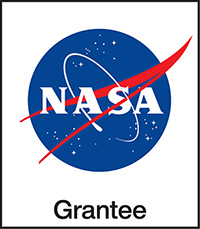How to Teach These Units
Explore all Space in Extreme Environments offerings, including background videos, downloads, learning pathways, and more!
Space Hazards Learning Pathways
In this unit, youth think and work like scientists and engineers as they plan to mitigate Earth and space hazards and design space gloves to protect against cold, impact, and dust. In both the science and engineering pathways, youth have the opportunity to build their problem solving, teamwork, communication, and creative thinking skills.
Science Pathway
Planetary scientists often use the technologies developed by engineers to further their understanding of the planets, satellites, and smaller bodies in the solar system. Often, these technologies help to mitigate the risks involved in space travel.
The science pathway supports youth exploration in the field of planetary science. Learners investigate hazards in space, such as dust storms, micro-impacts, and radiation. They explore how planetary scientists use data of this kind to plan missions.
Adventure 1: Everyday Hazards
Through a card game, youth are introduced to these concepts: hazards are dangers, and mitigation is a way to lessen the danger.
Adventure 2: Hazards on Earth
Youth are introduced to natural hazards as dangers and mitigation on Earth through a card matching game.
Adventure 3: Hazards in Space
Youth explore different hazards and mitigations in space and learn that some are the same as they are on Earth.
Adventure 4: Mitigate Hazards for Your Mission
Youth investigate the hazards and mitigations that apply to a specific mission and learn that they are different for human versus robotic missions.
Engineering Pathway
Materials engineering is an interdisciplinary field that draws upon physics, chemistry, and engineering to understand how materials behave. Materials engineers may combine existing materials such as metals, ceramics, and textiles to see how they perform under different conditions or design entirely new materials to meet the growing technological needs of society. All materials have distinct properties, such as strength, flexibility, and resistance to hot or cold temperatures, that can help determine how they can be used in a specific technology, from snowboards to spaceships.
The engineering pathway supports youth exploration of the field of materials engineering. Learners focus on designing gloves to protect astronauts against three space hazards: cold temperatures, impact, and dangerous dust.
Prep Adventure 1: What Is Engineering?
Youth engage in an engineering design challenge using an Engineering Design Process (EDP).
Prep Adventure 2: What Is Technology?
Youth consider the definition of technology as any thing or process that humans (engineers) design to solve a problem.
Adventure 1: Everyday Gloves
Youth investigate multiple glove types to determine which are better for certain tasks.
Adventure 2: Chilling Out
Youth explore how well different materials insulate against cold.
Adventure 3: Ready for Impact
Youth explore how well different materials protect against impact.
Adventure 4: Dangerous Dust
Youth explore how different materials resist or collect dust.
Adventure 5: Create a Space Glove
Youth apply what they learned in prior adventures to plan, create, and test a space glove designed for a space mission and its associated hazards.
Adventure 6: Improve a Space Glove
Youth improve their glove for more agility and strength or to better protect against the hazards of their space environment.
Adventure 7: Engineering Showcase
Youth prepare presentations to communicate their space glove design to others.

